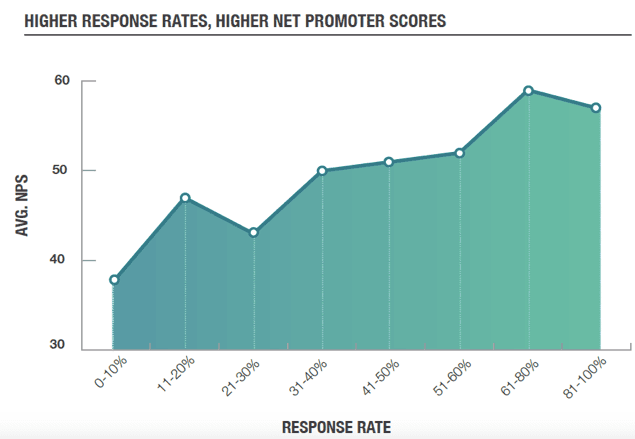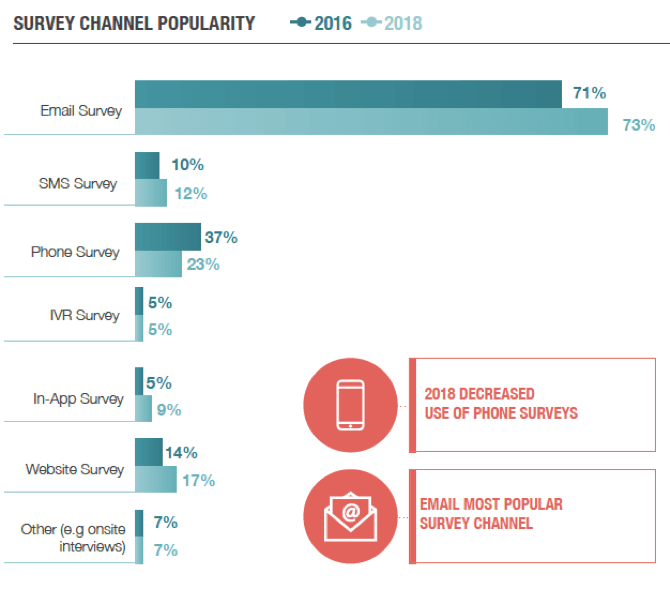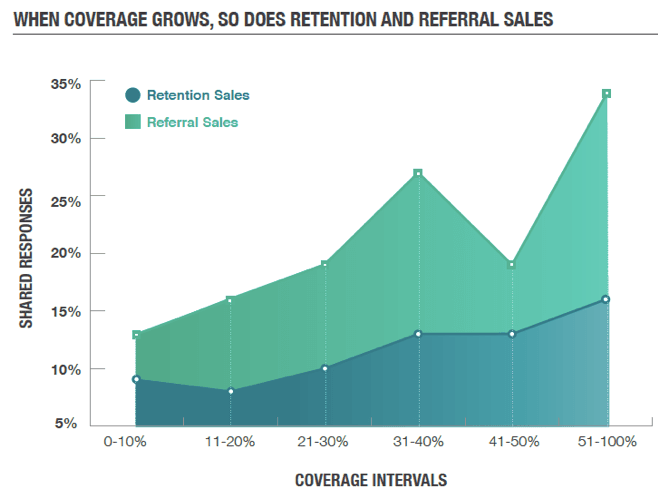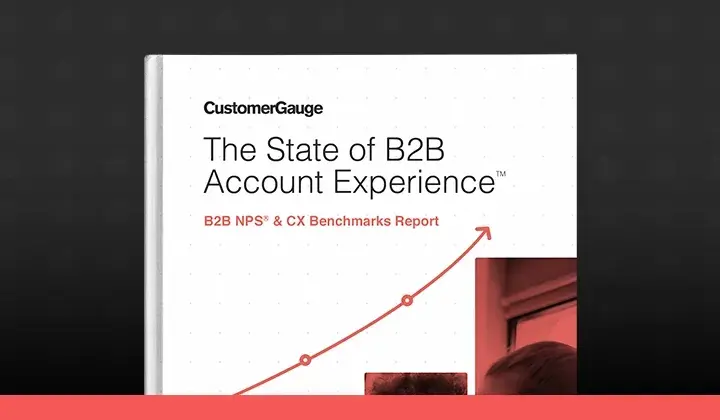For companies looking to understand how their customers are feeling about their products, or their customer service and experience, customer surveys are an excellent and powerful tool. Surveys give customers the opportunity to express what they like about certain goods and services, and what they don’t like, and therefore offer valuable data that can help a business improve its practices, and continue those that are already working for them.
One metric that has its heart in customer surveys is the Net Promoter Score® (NPS®). Surveys using the Net Promoter Score question ask “On a scale of 0 to 10, would you recommend this company to a friend?”—and the responses are what ultimately determine the score’s value. You can learn more about the Net Promoter Score and how it is calculate here.
Of course, surveys are only useful if you actually get responses; per the 2018 NPS® & CX Benchmarks Report, companies with higher survey response rates (61-80%) tend to have higher Net Promoter Scores.

Response rates are typically looked at for statistical significance only. And often, many companies will stop once they reach that threshold. However, the chart displayed above also touches on another important point: survey response rates can also be indicative of customer engagement. And, engaged customer tend to be more loyal!
We get it—easier said than done. According to our 2016 benchmarks report, the average survey response rate in 2016 was 31%. So, how can you hit a 50% survey response rate or more, where you start seeing the benefits in your Net Promoter Score, and where the collected data reflects your customer base in a significant way?
We’ve done a lot of research with companies to find out what areas should be focused on when it comes to getting not only higher response rates in surveys, but meaningful responses as well. In fact, we’ve written about it time and again.
In this article, we dipped into the CustomerGauge content library to bring you some suggestions for how you can make your customer surveys more effective.
6 Sure-Fire Tactics to Survey Success
Check out the six articles below for resources on how to get your survey response rates up, so you can engage your customers, and start improving your Net Promoter Score.
- Survey Construction: Why 3 questions is all it takes
Both this year’s benchmark survey and previous research conducted in the industry shows: keeping your surveys short and sweet increases survey completion and lowers abandonment rates. In fact, companies who keep their surveys between 2-6 questions see a minimum +2.3% increase in retention per year.
In this article, we dive into why short surveys—particularly Net Promoter® surveys—are ideal for capturing a snapshot of customer experience as opposed to long, traditional market research length surveys. Before you say “yes, well, don’t you need longer surveys to gain more valuable feedback on the root cause behind a score?”, don’t fret—there’s an answer for that too: drivers. - Survey Timing: When to Send Your Net Promoter® Surveys
Timing, as they say, is everything. Once you’ve constructed your survey, you need to, of course, send your surveys out, but the timing on when you choose to send them really matters.
We reached out to our Lead Customer Success Manager, Andrew Todtenkopf, on the best advice for when to send out relational or transactional surveys. This article he wrote is a fantastic guide for how to send either type of survey. And we’re not just talking about best day of the week. The advice here describes how to strategically plan based on business reviews, before a contract renewal, etc. Depending on whether you’re a B2B or B2C company, the information in here is vital. - Survey Sending: What is the best channel to collect customer feedback?
Email, SMS, on your site, on the phone—what’s the best channel to get survey responses from? Response rates are only part of what should determine your choice of survey channel, and this article tells you why.
In our past research, we’ve also found that email is typically the chosen and most effective method for surveying—year over year. The reason why might be fairly simple: frequency. Survey emails tend to have a less invasive feel compared to other methods. Because of this, companies can up the frequency of surveys, leading to higher response rates and trackable trends quarter over quarter.
- Survey Subject Lines: 6 Email Subject Line Strategies to Increase Your Survey Feedback
On that note, because survey emails are so popular, much of the remaining content here focuses on how to make the most of them. And, what better place to start with survey emails than the dreaded subject line?
Email subject lines are the first things your customers see when you send them an email survey request. This fun little article gives you some suggestions on how to make those subject lines irresistible so customers will click.
This article looks at how to balance the line between humor (we’re looking at you “Deals That Make Us Proud (Unlike Our Nephew, Steve”) and honesty (i.e., don’t treat your subject lines like a fairground to stretch the truth). At the end of the article, we provide an infographic that brings together the teachings. - Survey Introduction: What do I say in a survey email invitation?
You’ve gotten your customer to click on your email—now how do you get them to click on the survey link?
Word choice is important when communicating with customers, especially when you want them to do something. This article is a great resource on how to word survey invitations to your customers, particularly via email, though the principles can carry over to other channels, and how to avoid their spam folders in the process. Remember though: if you make a promise in a survey invitation, you have to keep it. If you promise to, for example, follow up on all comments, you better do it—or don’t expect people to take your survey again. - Survey Bounce Rates: Bounce Your Email Bounce Rate
Bounced emails are those emails that don’t send because the email address on record is typically inaccurate or out of date. In this article, our Lead Customer Success Manager describes best practices to keep bounce rates low. Be warned—a bit of spring cleaning is involved.
However, the benefits of doing so have widespread effects. Not only will doing so improve your overall email and survey metrics, but it also provides greater visibility into your customer base.
Bonus: It’s Not All About Survey Response Rates! THINK COVERAGE!
In our 2018 benchmarks report, and in the intro to this article, we mentioned the importance of looking at survey response rates from not only a statistical significance perspective, but a customer engagement one as well. However, we’ve often seen businesses shortcut their way to higher survey response rates by simply surveying a smaller “particular” group customers (i.e., those you know give good scores or are just more engaged).
This is…ill-advised. First, “cherry-picking” particular customers to survey DOES NOT give a wholesome view of your customer experience landscape (we actually call this practice “gaming”), nor an accurate Net Promoter Score.
In the benchmarks report, we also stressed the importance of survey coverage, or the “how large a part of your customer base the collected feedback covers.” In our research, we looked at how survey coverage correlated with two designated success factors: retention sales and referral sales. We found that when survey coverage grows so do these two financial factors.

Why is this? The higher your coverage, the more likely you are to reach out to more promoters. That’s why focusing on both survey response rates and survey coverage is vital. After all, the more promoters you know about, the more sales to existing customers and referrals you are likely to get. H&R Block Canada, for example, ties their Net Promoter and referral marketing programs together.
Conclusion
There’s so many things to consider when launching your survey campaigns. Hopefully the content provided here are a good guide for understanding how to optimize your next survey launch. If you’re interested in learning more about the survey benchmarks mentioned in this article or about more Net Promoter and CX benchmarks, click below to download the full report.

